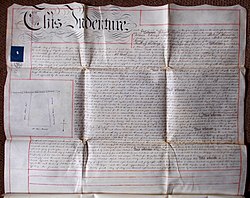Peter Bruff
Peter Schuyler Bruff (1812–24 February 1900) was an English civil engineer best known for founding the seaside resort town of Clacton on Sea, Essex, and for improving the lives of residents in the Essex towns of Walton-on-the-Naze, Colchester and Harwich, no less than for his important involvement in the planning and construction of the Suffolk railways, the renewal of the Ipswich sewerage system (completed 1881), and the Victorian revival of the Coalport porcelain factory, which he purchased in 1880. By the time of his death in 1900, Peter Bruff had helped turn what had thirty years before been an empty piece of farmland with a beach into the flourishing seaside town of Clacton on Sea.[1]
Early career

Bruff was born in Portsmouth. While working with Eastern Counties Railway from Shoreditch to Colchester, he began work on the Chappel Viaduct, which was constructed between 1847 and 1849.[2] The viaduct carries the Sudbury Branch Line across the Colne Valley in Essex. It stands 80 feet (24 m) above the river, has 32 arches and is 1,066 feet (325 m) long. The viaduct contains 4.5 million bricks.[3] It was Bruff's dream for the line to Colchester to carry on as far as Ipswich but the railway company did not have sufficient funds. As a result, Bruff formed his own company, the Eastern Union Railway, and built the line himself, including the 361 yd (330 m) tunnel through Stoke Hill by Ipswich railway station.[4]
Contributions to Walton
While working on the Ipswich line in 1855 he bought a house, Burnt House Farm, in Walton, an already an established but unremarkable town on the Essex coast near Frinton. He began to work on developing Walton as a recognized seaside resort. He took a major step in accomplishing this when in 1867, having accomplished the Ipswich line, he built another railway line, to Walton.[5] Peter Bruff's pier at Walton replaced an existing smaller pier which was blown down by a storm in 1881.[6] Bruff was also responsible for the building of the Marine Terrace, South Terrace (destroyed by bombing in World War II) and Clifton Baths (today the Pier Hotel).
Contributions to Clacton
Bruff is regarded by some as the Richard Branson of the 19th Century for the work he did in Clacton, which was virtually non-existent when he arrived.[7] Upon his arrival in 1864, Bruff made a private deal to buy 50 acres (200,000 m2), the central part of the town, for around £10,000. The land concerned centred on the area each side of the Pier and back as far as Rosemary Lane. In approximately 1870, work began on the seaside resort of Clacton-on-Sea. The Times in 1871 wrote "That being an entirely new creation and not the adaptation of an existing town, none of the evils inseparable from the old watering holes will be allowed to exist in it. There will be no slums, nor do any object that can offend the eye." When the pier opened, the town began truly to grow.[8]
His later constructions in the town included: the Royal Hotel in 1872, a public hall in Pier Avenue, which was destroyed by a fire in 1939, and the creation of the town centre. There is now a hospital ward and a residential road, both named in Bruff's memory.[9]
Coalport china works
Following the death of William Pugh in 1875, the Coalport china works of John Rose & Co., in Shropshire, were wound up, and the business was purchased by Peter Bruff in 1880.[11] He re-established it as a limited liability company, the Coalport China Company, under the management of his son Charles Bruff in 1889. After Peter Bruff's death in 1900 Charles became Director, and he rebuilt the works on the original site in 1902.[12] Under his vision and energy some of its former glory was revived. During the 1920s it fell again into financial difficulties and was eventually taken over by the Cauldon Potteries, Ltd., of Shelton, Staffordshire, in 1925.[13]
References
- Labrum, E.A. (1994). Civil Engineering Heritage. T. Telford. p. 282. ISBN 0-7277-1970-X.
- "The Viaduct at Chappel". The Colne-Stour Countryside Association. Archived from the original on 5 February 2008. Retrieved 11 March 2008.
- "Chappel Viaduct". Seven Man Made Wonders. BBC. Retrieved 11 March 2008.
- A.K.B. Evans and J.B Gough (eds), The Impact of the Railway on Society in Britain: Essays in Honour of Jack Simmons (Ashgate Publishing Ltd, 2003), p. 157. ISBN 0-7546-0949-9
- "Walton Town/Naze Park". Essex - Coast. BBC. 19 March 2005. Retrieved 11 March 2008.
- Bettley, James; David Andrews; Nigel Brown; James Kemble (2007). Essex. Yale University Press. p. 816. ISBN 0-300-11614-4.
- "Clacton's 19th Century Branson". This is Essex. 2000. Retrieved 11 March 2008.
- "Do you Remember Clacton's Steel Stella?". EADT 24. 22 July 2006. Retrieved 11 March 2008.
- "Clacton: Bruff Issue Raised in Commons". Clacton & Frinton Gazette. 26 July 2007. Retrieved 11 March 2008.
- "Obituary". The Times (36075). London. 26 February 1900. p. 6.
- G.A. Godden, Coalport and Coalbrookdale Porcelain (London 1970). See Shropshire Archives, Ref. 1190/3/1133-1294, especially extension 1229, see The National Archives Catalogue.
- J. Alfrey and C. Clark, The Landscape of Industry: Patterns of Change in the Ironbridge Gorge (Routledge 2005), p.99-100.
- M.F. Messenger, Coalport 1795-1926: An Introduction to the History and Porcelains of John Rose and Company (Antique Collectors' Club 1995), p. 406.
Further reading
- Moffat, Hugh (1987). East Anglia's First Railways. Lavenham: Terence Dalton. ISBN 0-86138-038-X.
- Jacobs, Norman (2002). Clacton Past. Chichester: Phillimore. ISBN 1-86077-225-0.